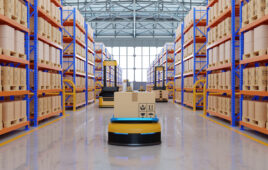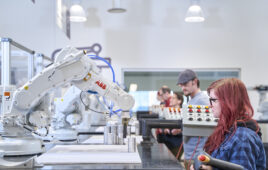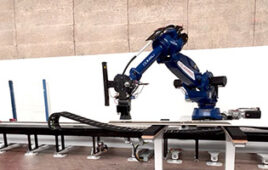New research from the laboratory of Ozgur Sahin, associate professor of biological sciences and physics at Columbia University, shows that materials can be fabricated to create soft actuators–devices that convert energy into physical motion–that are strong and flexible, and, most important, resistant to water damage.
“There’s a growing trend of making anything we interact with and touch from materials that are dynamic and responsive to the environment,” Sahin says. “We found a way to develop a material that is water-resistant yet, at the same time, equipped to harness water to deliver the force and motion needed to actuate mechanical systems.”
The research was published online May 21 in Advanced Materials Technologies.
Most traditional robotic systems are hard, that is, composed of metallic structures that require a computer to function. Soft robots are created with materials that don’t use a rigid skeleton or electricity to provide mechanical strength. They are simpler to make and less expensive than hard robots, more capable of complex motions and safer to use around humans.
The material developed by the Columbia researchers is made of a novel combination of spores–units produced by bacteria that are often used as food supplements–and adhesives. They provide an alternative to materials, such as synthetic polymers, commonly used in hard actuators and are better than the gels more generally used in soft actuators. Compared to the new material, gels are slower to respond, cannot generate high power or force and usually fail in direct contact with water.
Although the individual spores are water-resistant, they are so tiny that they must be bound together via a photochemical process in which high-intensity light instantly glues them together into a composite material. The researchers employ an inexpensive, commercially available UV light that is used in salons to cure nail polish.
Once dry, the material is stacked in layers to form a microscopic structure that expands or contracts with humidity or moisture, producing the force and motion of mechanical work.
“It’s like making sheets or surfaces from sand,” says postdoctoral research scientist Onur Cakmak, lead author of the study and a member of the research team. “The material is very granular.”
Guided by the pattern design, the porous composite can bend, fold and unfold in response to humidity or water. This gives the soft actuators agility and adaptability to their surroundings, much like organisms in nature. The ability to be patterned, says Cakmak, “is essential if you want to make useful systems out of these materials.”
Sahin sees many potential applications for the new material, from practical items to artistic creations. Actuators made from the water-resistant, humidity-responsive composite could be used to open a building’s windows when the humidity rises too high. The material could also be added to fabric in athletic clothing to help sweat evaporate faster. “We’re providing material for designers to work with and get their ideas realized quickly,” Sahin says.
Applications meant to function for years still need further testing, he adds, but those designed for shorter periods might already be ready for use.
“As we work on this, we also learn many other possible uses, some related to design and others to materials that could be part of the products around us,” says Sahin. “Those could be places where the impact of this could be sooner.”
Filed Under: Product design, Robotics • robotic grippers • end effectors




